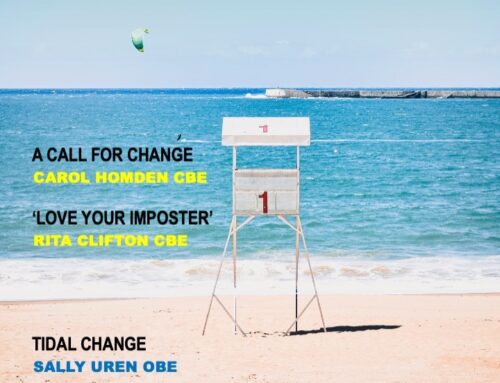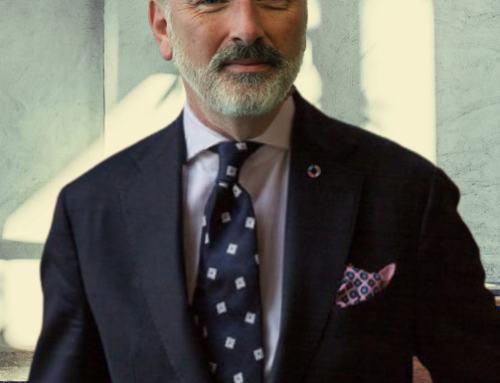GULP!

Gulp and double gulp: imagine the grief of a hungry fish swallowing bait, only to find it contains a barbed hook. Senior business leaders will soon know what that feels like as they wake up to the market implications of the public commitments their boards and companies have made to a wide range of sustainability goals.
And that’s a lot of companies, a lot of boards. Back in 2011, some 20% of S&P 500 business had produced sustainability (aka citizenship, CSR or ESG) reports. By 2020, that proportion had swelled to 90%, representing fully 80% of the equity of the largest U.S. corporations.
So what were they thinking as they made those pledges? Often it felt like the right thing to do, at a time when key customers were rattling their supply chains. There was a certain comfort, too, in the fact that the U.N. had established a framework for such commitments, with its 2015 Sustainable Development Goals. That same year, too, the Paris climate agreement had signalled that global standards, rules and regulations were set to tighten.
I have now spent 40 years working to shift business thinking on such issues, helping dozens of CEOs and scores of major businesses to evolve their priorities, targets and strategies. Unlike most advisors, however, we have pursued a twin-track approach. The first involves working, on a trusted advisor basis, to evolve the collective mindsets of top teams. The second, much less common, involves focusing new market pressures on those same businesses.
Back in the day, our million-selling Green Consumer Guide series spurred a global wave of auditing, reporting and supply chain challenges. My “triple bottom line” (aka People, Planet & Profit), launched in 1994, helped radically expand the change agendas top teams had to address. To help them along, 30 years ago, I had the Financial Times cartoonist draw the cartoon shown above. The image has served as a talisman as I have worked with an A-to-Z of companies worldwide.
My mission was to get the voices of nature (the fish), the socially disadvantaged (the woman) and the deep future (the robot) into boardrooms. One director of Greenpeace dubbed our strategy as “Greenpeace in pinstripes”. Our aim: to get different voices into top team discussions. No trivial task, but radically easier now that next generation leaders bring new values and priorities into the top echelons of business.
Once companies were hooked, we had to play them successfully. The intention was rarely to kill them, although with businesses producing asbestos, CFCs, DDT or lead that happened. Instead, we helped top teams imagine different futures, preparing themselves. Often this meant changing their CEOs and refreshing their top teams. Early on, such changes could be problematic. When green activist CEO Sir John Browne handed BP over to his protégé Tony Hayward, for example, the result was catastrophe—in the form of the worst-ever oil spill, from the Deepwater Horizon oil rig.
Nowadays, however, such successions are more likely to see a deeper embedding of the change agenda, as when Paul Polman handed over the helm of Unilever to Alan Jope. The latter has pushed the boundaries still further by publishing the company’s Regenerative Agriculture Principles.
Many CEOs still assume that sustainability implies a bit more transparency, a trifle more accountability, a dash of corporate philanthropy. Big mistake, huge. As oil companies like Chevron, Exxon and Shell are discovering, a seismic shift is happening in how society views fossil fuels. Shell’s CEO, Ben Van Beurden, recently wondered aloud whether his industry would find itself on “the wrong side of history”? His company’s defeat in a major court ruling, forcing a massive acceleration in its decarbonization efforts, and Exxon’s simultaneous defeat at the hands of a minnow, an activist hedge fund called Engine Number 1, suggests that the tide is turning—fast.
Corporate top teams that think they can lobby their way through using firms like Burson Marsteller (later known as BCW Global) notorious for defending the flanks of the asbestos, tobacco and fossil fuel industries, risk being exposed.
And, cranking up the pressure, a parallel shift is under way. The technologies that the PR and lobbying folk worked to so hard to defend are being upended by a series of disruptions. Think of what Elon Musk and Tesla did to the auto industry. Picture what it was like to lobby to protect the flanks of a rogue brand like VW, only to find your client self-disrupting by pivoting into electric vehicles. If you want a window into how markets will be disrupted, track RethinkX. What’s already happening to the fossil fuel and auto sectors will also happen to sectors as diverse as cattle ranching and dairying, and financial markets.
For decades, we have helped business embrace the ever-expanding corporate responsibility agenda—with recent additions including public access to health care, the malign effects of wealth divides, corporate tax evasion, and the unintended consequences of AI. But all that effort has signally failed to avert the incoming tsunami of “wicked” problems. That’s why we now hear so much talk about “resilience”—the resilience of individuals, families, teams, organizations, supply chains, industries, economies and, ultimately, of our climate and biosphere. Reason: the economic, social, political and environmental systems on which our wellbeing depends are wobbling, signalling serious instabilities.
In launching the first-ever “product recall” of a management concept in 2018, through the Harvard Business Review, I have been one of the voices calling time on the CSR- (and now ESG)-as-usual agenda. Many leaders assume that talking up the need for resilience will ensure effective, timely action. Good luck. The only thing that will do that is a re-commitment by business and government leaders to sustainability as a regenerative agenda. Making things less bad, as challenging voices in the sustainability space have insisted for some time, is not remotely enough. Nor is the growing number of commitments to net-zero greenhouse gas emissions.
All helpful, but what we need now is clear-eyed commitments to building a truly Regenerative Economy, restoring past damage and creating the conditions in which our societies and nature can flourish over generations. In short, the sort of long-term thinking and action spotlighted in that long-ago cartoon of the robot with its “3001” shoulder flash.
This is an ambitious agenda, for which most boards are ill-prepared. To get a better handle on it, we are working with Board Intelligence to prepare boards and C-suites for the coming challenges and opportunities. We already hear people like Walmart CEO Doug McMillon committing the giant retailer to becoming a regenerative business, while PepsiCo promises to regenerate 7 million acres of farmland. But, while welcome, even such initiatives as these are not going to be enough on their own.
So the multi-billion—and some cases trillion—dollar question for your top team is this: What are you, and what should you be, doing to prepare your business to succeed in tomorrow’s Regenerative Economy?
John Elkington
Founder & Chief Pollinator at Volans
https://volans.com/Creator of the Green Swans Observatory
Author of Green Swans:
https://theobservatory.volans.com/
The Coming Boom in Regenerative Capitalism.
To register for the 2021 Tomorrow’s Capitalism Forum,
on June 23, please click here – https://us02web.zoom.us/webinar/register/WN_dAsjusq3Tc6iQ9TAgbNIsg
This article also appears at https://www.imd.org/


GULP!

Gulp and double gulp: imagine the grief of a hungry fish swallowing bait, only to find it contains a barbed hook. Senior business leaders will soon know what that feels like as they wake up to the market implications of the public commitments their boards and companies have made to a wide range of sustainability goals.
And that’s a lot of companies, a lot of boards. Back in 2011, some 20% of S&P 500 business had produced sustainability (aka citizenship, CSR or ESG) reports. By 2020, that proportion had swelled to 90%, representing fully 80% of the equity of the largest U.S. corporations.
So what were they thinking as they made those pledges? Often it felt like the right thing to do, at a time when key customers were rattling their supply chains. There was a certain comfort, too, in the fact that the U.N. had established a framework for such commitments, with its 2015 Sustainable Development Goals. That same year, too, the Paris climate agreement had signalled that global standards, rules and regulations were set to tighten.
I have now spent 40 years working to shift business thinking on such issues, helping dozens of CEOs and scores of major businesses to evolve their priorities, targets and strategies. Unlike most advisors, however, we have pursued a twin-track approach. The first involves working, on a trusted advisor basis, to evolve the collective mindsets of top teams. The second, much less common, involves focusing new market pressures on those same businesses.
Back in the day, our million-selling Green Consumer Guide series spurred a global wave of auditing, reporting and supply chain challenges. My “triple bottom line” (aka People, Planet & Profit), launched in 1994, helped radically expand the change agendas top teams had to address. To help them along, 30 years ago, I had the Financial Times cartoonist draw the cartoon shown above. The image has served as a talisman as I have worked with an A-to-Z of companies worldwide.
My mission was to get the voices of nature (the fish), the socially disadvantaged (the woman) and the deep future (the robot) into boardrooms. One director of Greenpeace dubbed our strategy as “Greenpeace in pinstripes”. Our aim: to get different voices into top team discussions. No trivial task, but radically easier now that next generation leaders bring new values and priorities into the top echelons of business.
Once companies were hooked, we had to play them successfully. The intention was rarely to kill them, although with businesses producing asbestos, CFCs, DDT or lead that happened. Instead, we helped top teams imagine different futures, preparing themselves. Often this meant changing their CEOs and refreshing their top teams. Early on, such changes could be problematic. When green activist CEO Sir John Browne handed BP over to his protégé Tony Hayward, for example, the result was catastrophe—in the form of the worst-ever oil spill, from the Deepwater Horizon oil rig.
Nowadays, however, such successions are more likely to see a deeper embedding of the change agenda, as when Paul Polman handed over the helm of Unilever to Alan Jope. The latter has pushed the boundaries still further by publishing the company’s Regenerative Agriculture Principles.
Many CEOs still assume that sustainability implies a bit more transparency, a trifle more accountability, a dash of corporate philanthropy. Big mistake, huge. As oil companies like Chevron, Exxon and Shell are discovering, a seismic shift is happening in how society views fossil fuels. Shell’s CEO, Ben Van Beurden, recently wondered aloud whether his industry would find itself on “the wrong side of history”? His company’s defeat in a major court ruling, forcing a massive acceleration in its decarbonization efforts, and Exxon’s simultaneous defeat at the hands of a minnow, an activist hedge fund called Engine Number 1, suggests that the tide is turning—fast.
Corporate top teams that think they can lobby their way through using firms like Burson Marsteller (later known as BCW Global) notorious for defending the flanks of the asbestos, tobacco and fossil fuel industries, risk being exposed.
And, cranking up the pressure, a parallel shift is under way. The technologies that the PR and lobbying folk worked to so hard to defend are being upended by a series of disruptions. Think of what Elon Musk and Tesla did to the auto industry. Picture what it was like to lobby to protect the flanks of a rogue brand like VW, only to find your client self-disrupting by pivoting into electric vehicles. If you want a window into how markets will be disrupted, track RethinkX. What’s already happening to the fossil fuel and auto sectors will also happen to sectors as diverse as cattle ranching and dairying, and financial markets.
For decades, we have helped business embrace the ever-expanding corporate responsibility agenda—with recent additions including public access to health care, the malign effects of wealth divides, corporate tax evasion, and the unintended consequences of AI. But all that effort has signally failed to avert the incoming tsunami of “wicked” problems. That’s why we now hear so much talk about “resilience”—the resilience of individuals, families, teams, organizations, supply chains, industries, economies and, ultimately, of our climate and biosphere. Reason: the economic, social, political and environmental systems on which our wellbeing depends are wobbling, signalling serious instabilities.
In launching the first-ever “product recall” of a management concept in 2018, through the Harvard Business Review, I have been one of the voices calling time on the CSR- (and now ESG)-as-usual agenda. Many leaders assume that talking up the need for resilience will ensure effective, timely action. Good luck. The only thing that will do that is a re-commitment by business and government leaders to sustainability as a regenerative agenda. Making things less bad, as challenging voices in the sustainability space have insisted for some time, is not remotely enough. Nor is the growing number of commitments to net-zero greenhouse gas emissions.
All helpful, but what we need now is clear-eyed commitments to building a truly Regenerative Economy, restoring past damage and creating the conditions in which our societies and nature can flourish over generations. In short, the sort of long-term thinking and action spotlighted in that long-ago cartoon of the robot with its “3001” shoulder flash.
This is an ambitious agenda, for which most boards are ill-prepared. To get a better handle on it, we are working with Board Intelligence to prepare boards and C-suites for the coming challenges and opportunities. We already hear people like Walmart CEO Doug McMillon committing the giant retailer to becoming a regenerative business, while PepsiCo promises to regenerate 7 million acres of farmland. But, while welcome, even such initiatives as these are not going to be enough on their own.
So the multi-billion—and some cases trillion—dollar question for your top team is this: What are you, and what should you be, doing to prepare your business to succeed in tomorrow’s Regenerative Economy?
John Elkington
Founder & Chief Pollinator at Volans
https://volans.com/Creator of the Green Swans Observatory
Author of Green Swans:
https://theobservatory.volans.com/
The Coming Boom in Regenerative Capitalism.
To register for the 2021 Tomorrow’s Capitalism Forum,
on June 23, please click here – https://us02web.zoom.us/webinar/register/WN_dAsjusq3Tc6iQ9TAgbNIsg
This article also appears at https://www.imd.org/





